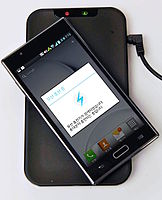
Photo from wikipedia
Wireless body sensor networks are becoming a ubiquitous solution to preventing chronic illnesses for a population with an ever-increasing number of elderly people. Through constant and real-time health monitoring, caregivers… Click to show full abstract
Wireless body sensor networks are becoming a ubiquitous solution to preventing chronic illnesses for a population with an ever-increasing number of elderly people. Through constant and real-time health monitoring, caregivers and medical personnel, and even patients themselves, can act more quickly in the event of a critical situation. The design of wireless body sensors must have several characteristics that enable their integration into the wearer’s life as seamlessly and unobtrusively as possible. Thus, how these sensors are powered becomes a topic of interest. Much research and work have been conducted on using thermoelectric generators to convert the waste heat from human metabolic activities into useful electricity to perpetually power these devices. The concept of an effective wireless body sensor network is also studied in this work. Analytical approaches are applied to a commercial module as an energy-scavenging device based on data gathered from a wide literature review. The ideal model is further optimized using a dimensionless approach to determine the feasibility of the optimized device in terms of implementation and performance. Finally, a design that considers all parameters of an effective energy-scavenging device is proposed alongside work for the future.
Journal Title: International Journal of Energy and Environmental Engineering
Year Published: 2020
Link to full text (if available)
Share on Social Media: Sign Up to like & get
recommendations!